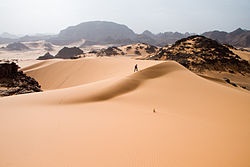|
|
| |
|
|
| |
|
|
|
|
| |
 |
| Tadrart Acacus
desert in western Libya, part of the Sahara. |
Conservation
Conservation biology is the study of the conservation of
nature and of Earth's biodiversity with the aim of
protecting species, their habitats, and ecosystems from
excessive rates of extinction and the erosion of biotic
interactions. It is an interdisciplinary subject drawing
on natural and social sciences, and the practice of
natural resource management.
The conservation ethic is based on the findings of
conservation biology.
Origins
The term conservation biology and its conception as a
new field originated with the convening of "The First
International Conference on Research in Conservation
Biology" held at the University of California, San Diego
in La Jolla, California in 1978 led by American
biologists Bruce A. Wilcox and Michael E. Soulé with a
group of leading university and zoo researchers and
conservationists including Kurt Benirschke, Sir Otto
Frankel, Thomas Lovejoy, and Jared Diamond. The meeting
was prompted by the concern over tropical deforestation,
disappearing species, eroding genetic diversity within
species. The conference and proceedings that resulted
sought to initiate the bridging of a gap between theory
in ecology and evolutionary genetics on the one hand and
conservation policy and practice on the other.
Conservation biology and the concept of biological
diversity (biodiversity) emerged together, helping
crystallize the modern era of conservation science and
policy. The inherent multidisciplinary basis for
conservation biology has led to new subdisciplines
including conservation social science, conservation
behavior and conservation physiology. It stimulated
further development of conservation genetics which Otto
Frankel had originated first but is now often considered
a subdiscipline as well. |
|
|
Conservation of natural
things |
- Conservation biology, the science of
the protection and management of biodiversity
- Conservation genetics - "an
interdisciplinary science that aims to apply genetic
methods to the conservation and restoration of
biodiversity."
- Conservation movement, to protect
plants, animals and their habitats
- Conservation (ethic), an ethic of
resource use, allocation, and protection, especially of
the natural environment
- Conservationist, a person who
advocates for conservation of plants, animals and their
habitats
- Energy conservation, the reduction
of non-renewable energy consumption
- Habitat conservation, a land
management practice that seeks to conserve, protect and
restore, habitat areas for wild plants and animals
- Water conservation, reducing the use
of water to protect the environment
- Wildlife management,
multidisciplinary practices, including conservation of
species and their habitats
- Marine conservation, the protection
and preservation of ecosystems in oceans and seas
- Soil conservation, management
strategies for prevention of soil being eroded from the
earth’s surface or becoming chemically altered
|
|
|
Conservation of made things |
- Art conservation, protecting works
of art
- Conservation-restoration, the
profession devoted to the preservation of cultural
property
- Photograph conservation
- Architectural conservation
|
|
|
Other |
- Conservation laws, a set of laws in
physics
- Conserved sequence - "similar or
identical sequences which may occur within nucleic acid
sequences, protein sequences, protein structures or
polymeric carbohydrates".
- Conservation (psychology), learning
development of logical thinking, according to Jean
Piaget
- Conservation authority (Canada)
- Conserved name (Latin nomen
conservandum), a scientific name with specific
nomenclatural protection.
|
 Kiddle: Conservation Kiddle: Conservation
Wikipedia: Conservation
Wikipedia: Conservation biology
|
|
|
|
|
|
|
|
|
|
|
|
|
|
|
|
|
Search Fun Easy English |
|
|
|
|
|
|
|
|
|
|
|
|
|
|
|
About
Contact
Copyright
Resources
Site Map |